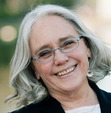Edith Maxwell's Blog, page 12
August 19, 2024
Meet the Twomblys with Alyssa Maxwell – and a giveaway
By Liz, happy to welcome Alyssa Maxwell back to talk about the family at the center of her latest Gilded Newport Mystery, Murder at Vinland. And she’s doing a giveaway! Take it away, Alyssa!
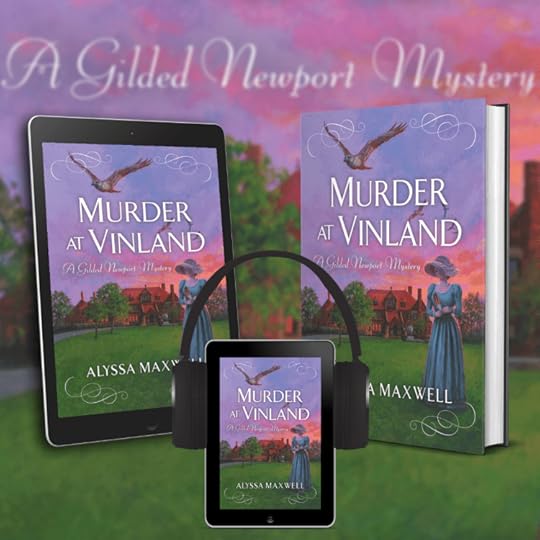
Twombly—That’s a Funny Name!
Apparently, it’s of British origin, but the Twomblys who inhabit Murder at Vinland, my latest Gilded Newport Mystery, were American through and through. Hamilton Twombly was a businessman who worked as William Henry Vanderbilt’s financial adviser at the New York Central Railroad, and also served on the board of directors on several other railroads around the country.
But it’s not him we’re concerned with here, but his wife, Florence Adele Vanderbilt Twombly. Florence was William Vanderbilt’s daughter, making her the first Cornelius’s granddaughter and the sister of Cornelius II, who owned The Breakers in Newport. Now, we all know the story, played out fictionally in Julian Fellows’s The Gilded Age, of how Florence’s sister-in-law, Alva Vanderbilt, used her wits to persuade Caroline Astor to accept the Vanderbilt family into Society. But unlike Mrs. Astor, women like Alva, Mamie Fish, and Theresa Fair Oelrichs were known for their ostentation and “new money” antics and enjoyed seeing their names in the society columns.
Not so Florence Twombly. Much like Mrs. Astor and other blue-blooded, Knickerbocker wives, she abhorred publicity and turned up her nose at the press. Further reading, especially a memoir written by her French chef later in the 20th century, cemented in my mind the image of an intelligent, formidable woman who lived according to her own terms. She embodied a certain spirit that very much helped define Newport in the Gilded Age, and because of this, I chose to write Murder at Vinland with a particular focus on women—from the victims to the suspects to everyone in between. There are a couple of men here and there, but this is a story for the ladies.
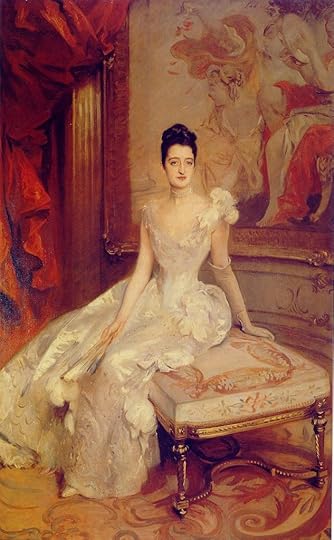
Yes, men held the power when it came to the business of making money. They were the captains of industry, the robber barons, and controlled the business world from their board rooms in New York City. But money wasn’t enough for the families of the Four Hundred. They needed power, both politically and socially, and when it came to the latter, it was the women who were in charge. They determined who mattered and who didn’t, and they created powerful dynasties through the strategic marriages of their children. Vanderbilt, Astor, Wilson, Goelet, Van Alen—these are just a few society names that formed intricate connections through marriage.
Much of this strategizing and maneuvering took place in Newport during the Summer Season at balls, dinner parties, luncheons, picnics, and sporting events, etc., with women planning the social schedule and the men showing up accordingly. In short, during those six to eight weeks each year, women were the heads of their families.

Female strength is symbolized in the very house Florence Twombly lived in in Newport. Vinland was built in the 1880s by Catherine Lorillard Wolfe, an heiress (real estate and tobacco money) who never married and therefore controlled her own fate and finances. Inspired by legends of Vikings landing in Newport a millennium ago, she had imagery from Norse mythology incorporated into the design of the house. I make use of that fierce, warrior imagery when describing the relationship between Florence and my sleuth, Emma Cross. Unlike Emma’s relationship with other members of the Vanderbilt family, she and Florence aren’t close, with Florence often disapproving of Emma’s lifestyle. By the end of the book, though, they do find some common ground—that of being women in control of their lives. Not to mention Emma solving the murder that takes place at Vinland.
Readers: is there a woman whose strength inspires you? Could be someone you know, someone from history, or maybe one of the amazing athletes we saw during the Olympics. Share below to be entered for a chance to win a signed hardcover copy of Murder at Vinland! (For U.S. residents only due to shipping costs.) A winner will be chosen randomly and announced/contacted the next morning.
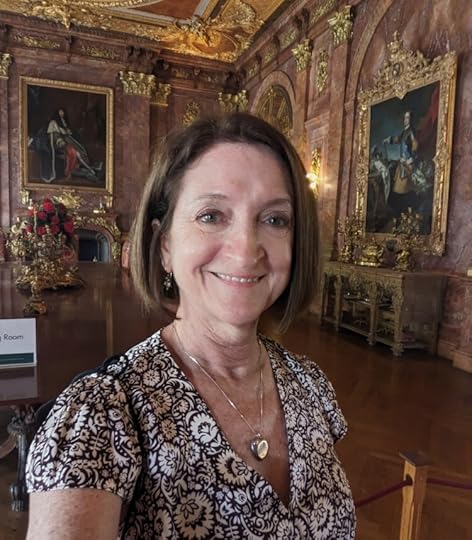
Alyssa Maxwell is the author of The Gilded Newport Mysteries and A Lady & Lady’s Maid Mysteries. A former nonfiction and fiction editor, Alyssa began writing at an early age. Growing up in New England and traveling to Great Britain fueled a passion for history, while a love of puzzles drew her to the mystery genre. She and her husband live in Florida, where they enjoy bike riding, antiquing, hiking nature trails, and shopping at the farmer’s markets, but their hearts remain in Newport, RI. You can learn more about Alyssa and her books at www.alyssamaxwell.com and connect with her on social media at:
Facebook – Gilded Newport, Facebook – Alyssa Maxwell, Instagram, Goodreads, Twitter
August 16, 2024
Cozy Writers on Writing the Cozy Mystery
Edith/Maddie, back from two weeks of vacation and writing from north of Boston.
I’m delighted to share the news that a new collection of essays is out that addresses how to write the cozy mystery! Retired university professor Phyllis Betz edited Writing the Cozy Mystery: Authors’ Perspectives on Their Craft
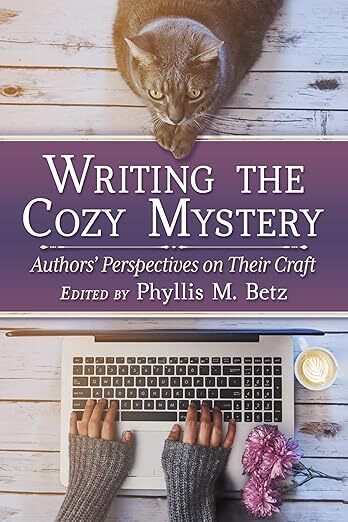
Sherry, Julie, and I have essays in the book, along with plenty of other authors, including a number of FOWs (Friends of the Wickeds). Even if you don’t write mysteries, you’re going to want to read this for an inside look at how we write. Sherry starts off the collection with “In Defense of Cozy Mysteries.” Julie’s is titled “Fair Play in Cozies,” and mine is (no surprise) “Writing Multiple Series.”
And if you happen to be a Sisters in Crime member, you can find a discount code on the SINC National web site. However you get there, we hope you’ll find your way to a copy of the book and then tell everyone you know about it. My fellow Wickeds in the collection helped me put together several queries for our esteemed editor.
We’re delighted to have Phyllis here today to answer a few of our questions!
What did you learn about cozies while putting this book together?
I learned how flexible the genre is. I’ve always believed that any genre fiction works best when writers know and use the conventions well. But, like any good writer, they know how to manipulate them (in a good sense) to allow new characters, situations, and topics to appear in the pages of the novel.
What surprised you regarding the essays?
How conscientious all of the contributors are about creating the best story they can; how aware you are about the role the reader plays in the creation and development of the narrative; and the depth of knowledge you have about the history of the genre. Although, I really wasn’t surprised; I’d say the essays confirmed what I assumed about careful and committed writers.
What inspired you to study cozies?
I have read mysteries for, it seems, forever. My parents both read them as well as my sisters. I read Christie, of course, Patricia Wentworth, Mignon Eberhart, Charlotte Armstrong, Nero Wolf and many more. Most of these were not labeled as cozy then, but they fit the criteria. So, I enjoyed them before looking at them as an academic. I consider myself a cultural critic and am fascinated by how literature—popular and literary—reflects and comments on society. I also believe that popular works often more accurately reflect the world and people’s interests and concerns than canonical authors. This has been the focus of my work on genre fiction. When I taught literature, I made sure to include one or two lesser-known writers in my syllabus. Shameless plug here—the postscript in the anthology lays out my ideas in greater detail than I can put here.
Are there others studying the cozy?

All of the contributors to the Reading the Cozy Mystery: Critical Essays on an Underappreciated Subgenre anthology, which came out in 2021, were some of the first academic critics to give the cozy serious examination and analysis. I recently received an email from a student who wrote her senior honor’s thesis on the cozy, using the first anthology in her discussion. I am not aware of more current academic work on the cozy, but that doesn’t mean there aren’t people working on the cozy.
After this year’s Malice, I am trying to put together another panel on cozy mysteries because I discovered there is still much to investigate. (Who knows, if the panel comes to fruition, there may be another critical anthology.)
Do you read cozy mysteries for pleasure/what other genres do you read?
Mysteries are my primary fun reading—whatever the genre. I thoroughly enjoy cozies. In fact, I’ve converted my youngest sister to them. Historical crime, both fiction and non-fiction, forensic detective fiction, but not too gory. I’ve read hard-boiled, but it’s not my first choice. I am also addicted to the Investigation Discovery Channel and Ovations murder mystery mornings, which are typically cozy—Shakespeare and Hathaway, Death in Paradise, The Dr. Blake Mysteries.
How did you decide to organize the anthology?
When I sent out the call for contributors, I had a list of the most common approaches, characters, setting, the form, etc. I left the topic up to each writer. Once the essays came in, I basically considered the focus of each essay and put them into categories. Interestingly, the largest number dealt with the genre, why an author chose it, how they used the conventions in their work. I put that category first because it seemed appropriate as it set up a framework for the other categories. The sections on characters and settings provided specific illustrates of these major components of the form. I suppose I could have separated out the essays that treated theme, but at the time, I didn’t think of it. But, since the theme is so much a part of the genre’s formulation, keeping these essays together made sense.
Thank you for joining us today, Phyllis! Now, please tell our readers about yourself.

For 32 years I taught at La Salle University in Philadelphia, PA. My background is in American literature, with a focus on late 19th century women writers. I have been a reader of mysteries for many years and began studying them from an academic lens with lesbian detective fiction. This led to focusing on genre literature, particularly the mystery. Since then, the mystery has been my main area of interest. I retired from teaching three years ago and now have more time to devote to reading and analyzing mysteries.
Readers: What draws you to the cozy mystery? Do you mix your reading with other genres or stick to one? You can also ask Phyllis, Sherry, Julie, or me a question. And don’t forget to pick up your copy of Writing the Cozy Mystery: Authors’ Perspectives on Their Craft.
August 15, 2024
Hooray, I’m A Debut Author: What’s Next? with guest Angela Crook
By Liz – so excited to welcome Angela Crook to the blog! Julie and I had the pleasure of meeting and hanging out with Angela at Left Coast Crime earlier this year, where she was celebrating the launch of her debut thriller, Hurt Mountain. She’s here talking about that journey. Take it away, Angela!

So, you did it. You wrote the book. You got the agent. You got the book deal. A year or two later, you get to hold your book in your hands and watch in near panic as reviews, proof that strangers are reading your work, come rolling in. You have the party. You make the social media announcements and all hail your literary brilliance. Great. Wonderful. All your dreams are about to come true. You’re going to be a star. Your book will become a movie and people will finally call you the black Stephen King. Then this awful thing called reality creeps in as you hear these words, “So, what’s next?”
Shortly after my debut novel, Hurt Mountain, was released, I had the pleasure of spending a little time with friend and international best-selling author extraordinaire Catriona McPherson. As she got up to leave, she said, “You’re already working on your next one, right?” To which I nodded and smiled, of course. Meanwhile, my brain was screaming, Next? Already?
Yes! That is the question. What’s next? The thing is, all those days and nights that I spent dreaming of becoming a published author, soaring to the heights where all my literary heroes lived, I never considered this would be a question at all. I had written books before, three of them as a matter of fact, published as an indie author. I think they’re pretty good too. Check them out, if you’re so inclined: Fat Chance, Chasing Navah, and Maria’s Song. All available on Amazon for your reading pleasure. So, why did this question send me into a full-on panic?



After all, the climb to get to this point, my first traditionally published novel, had been a brutal slog that I may have never made without the help of some of the best crime writers out there today, like Kellye Garrett, Amina Aktar, and Yasmin Angoe, whom I had the great pleasure to meet through the Crime Writers of Color group. By the way, if you are a writer of color, I highly recommend connecting with this group. The support you will receive here may be the thing that will help you keep pushing!
The more I tried to answer that question, the more stuck I became until days, then weeks, then months went by without any words being written while I tortured myself with what ifs. What if my agent dumps me? What if my publisher hates my next book? What if I am a, gasp, one-book wonder (Wonder may be a stretch)?
These were the thoughts that sent me skittering away from my computer in horror. I needed help— something, someone to grab me by the shoulders and shake the self-doubt and fear right out of my head and back onto the page. Enter Mr. Stephen King, appropriate since he was the one who started me down this path in the first place. I grabbed On Writing: A Memoir of the Craft from the shelf, the writing bible in my eyes, and began to read like I hadn’t already read it at least three times before. It was a great reminder of some things I already knew, but maybe wasn’t practicing as much as I should. Read. Writers have to read. Reading is practice for the craft. I believe that as much as Mr. Stephen King. But even more, I needed to remember to show up. Every day, whether the inspiration was near or far. Show up and often the words would too.
And as I read, I felt the fear start to leak away, first in drips and drops, then in gushes, until finally that fear morphed into the excitement of a brand-new idea, bringing with it a reminder that ideas are as plentiful as the midges that drift in from beautiful Lake Erie to lay siege to the city at least once a year.
My debut novel, Hurt Mountain, is a beautifully dark story of tragedy, redemption, love, and of course family; All my stories seem to revert back to family in time.
So, what’s next? More of the same, I hope. As I type this, I’ve plucked my next idea from that vast idea cloud in the sky, and I’m in my writing-with-the-door- closed era, but I can’t wait to see where this story goes.
Readers: How do you prepare to take on something scary? One commentor (US only) will be randomly selected to receive a copy of Hurt Mountain. To be entered in the giveaway, please heart this post and include your email address.
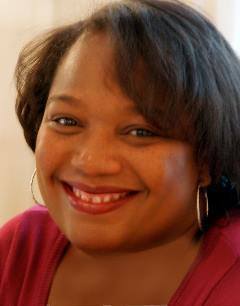
Originally from Cleveland, Ohio, Angela Crook lives in Shaker Hts., with her son, and 3 crazy kitties. She served eleven years in the United States Air Force. She is a proud member of a writer’s group of three other up-and-comers (the Literary Llamas) who meet once a month to critique, encourage, and revel in the pursuit of literary greatness. She has three self-published novels, “Fat Chance,” “Chasing Navah,” and “Maria’s Song,” and a short story, “Bitter,” featured in the anthology, “Cleveland Noir,” available August 1, 2023, and her first traditionally published novel, “Hurt Mountain.,” with a released March 1, 2024. Angela can be found on Twitter at @navah74 Facebook at @AngelaCrookAuthor IG Angela__Crook.
August 14, 2024
Wicked Wednesday – Controversial Female Characters
We’re in the theme of “the heat is on” since it’s August and still awesomely hot out! Today, let’s talk about the women who are not only fiery, but who aren’t “typical” women – meaning maybe they’re unlikeable, definitely controversial and just challenging the normal stereotype.
My new favorite controversial female characters is a semi-recurring character in suspense novelist Peter Swanson’s books, Lily Kintner. She isn’t a great person, by her own admission, yet she’s someone you find yourself rooting for regardless. At the risk of spoilers I won’t say more, but she’s a force.
Wickeds, what about you? Who’s your favorite controversial female character?

Julie: Liz, you know I’m a Lily fan as well. Like you, I won’t post a spoiler. But she’s really terrific. I’m also grateful you didn’t couch this as unlikeable, which is often a phrase used to describe challenging women. I just read a book, Every Time I Go on Vacation, Someone Dies. The protagonist, Eleanor Dash, isn’t controversial per se, but the book has interesting first person narration, and Eleanor does not paint herself as a hero.
Edith/Maddie: I’m coming up empty on contemporary controversial female characters, but I can think of plenty in the historical mysteries I love. Alyssa Maxwell’s Gilded Newport reporter of a hundred years ago Emma Cross is related to the moneyed families but needs to earn a living – and solve crimes while she’s doing it. She drives her own buggy around town and gets a lot of negative reaction. My own midwife Rose Carroll similarly is an independent businesswoman and a controversial outsider, as is Nancy Herriman’s nurse/sleuth Celia Davies in her Old San Francisco mysteries.
Jessie: I love the Amelia Peabody novels by Elizabeth Peters. Her behavior is often not considered ladylike for her era. I would also add Stephanie Plum to the list as she is not the stereotypical bounty hunter. I think of Carol Jordan in the Tony Hill and Carol Jordan books by Val McDermid as, if not controversial, complicated and tough. Those qualities are not always easily accepted in women by many.
Barb: When I read, “controversial female character,” I immediately thought of Amy Elliott Dunne, the girl who is gone in Gone Girl. It’s hard to think of a more loathsome female psychopath. Though I’m not sure she’s “controversial” as such. She is pretty much universally hated. Some people hate all the characters in Gone Girl, but I found them more nuanced. Except for Amy.
Readers, who is your favorite controversial female character? Tell us in the comments!
August 13, 2024
An IRL-inspired Halloween town, and a giveaway – Welcome Emmeline Duncan
By Liz, happy to welcome Emmeline Duncan back to the blog! Emmeline and I are like soul sisters – she writes about coffee, dogs and now a Halloween-themed town that rivals my very own Salem, Mass. What could be more fun? She’s celebrating the first book in that new series, Chaos at the Lazy Bones Bookshop and she’s here to talk about the town. This book is so fun and I can’t wait for you to read it. Take it away, Emmeline!
If you try to find Elyan Hollow, Oregon, the setting of Chaos at the Lazy Bones Bookshop, on a map, you’ll struggle. Because sadly, Elyan Hollow doesn’t exist outside the Halloween Bookshop Mystery Series.
But you can visit its real-life inspiration.
When an author sits down to write a book, location is always a crucial part of the story. My Ground Rules series is based in Portland, Oregon, which, as you hopefully know, is a real place. When I decided to write a Halloween-themed series about a bookshop, I needed to make a decision: set the series in a quirky Portland neighborhood or create a fictional location.
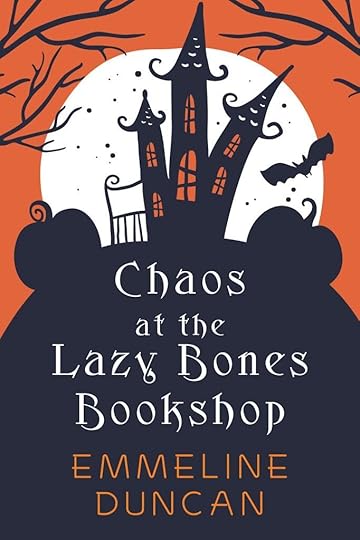
I opted for the fictional route, except I borrowed from reality.
St Helens, Oregon, about thirty minutes west of Portland on the Columbia River, is the inspiration for Elyan Hollow. Each year, St Helens holds a “Spirit of Halloweentown” festival from late September through October. The town was the filming site for the Halloweentown movies, which starred Debbie Reynolds and Kimberly J. Brown, and encouraged a generation of children to wish they, too, had a magical heritage. (You can also find Bella’s house from the Twilight films in town, plus a handful of other filming sites.)
 During the festival, you’d find this park full of pumpkins and visitors taking Halloweentown photos.
During the festival, you’d find this park full of pumpkins and visitors taking Halloweentown photos.My fictional town was also the filming site of a beloved Halloween movie, and it has embraced its fame to rebrand as a year-round spooky destination.
Crafting a fictional location allowed me to create the town, festival, and bookshop of my dreams, complete with all the seasonal puns that organically fit in. By going the fictional town route, I rearranged downtown and added the “Goblin Gate Park”, home of the annual hay bale maze, and fun shops I’d love to drop by. It also means I can have my protagonist, Bailey, trip over dead bodies without casting aspersions on the real-life town and festival, which has a very low violent crime rate, and they never need a bookseller to solve murders, unlike Elyan Hollow’s cozy murders.
Creating the bookstore of my dreams was one of my favorite parts. Bailey has taken over the bookshop founded by her grandparents. She’s up for the challenge and decides the one thing the town’s annual festival is missing is a lit festival. So, she recruits the local library and multiple businesses onboard to create the Spooky Season Literary Festivals. She even gets hometown hero Rex Abbot, bestselling horror author, to make his first appearance in town since he left almost 30 years before after graduating high school. Of course, this decision has reverberations, leading Bailey to discover the town’s dark side.
Lazy Bones Bookshop has a shop dog, Jack, who is based on my real-life rescue dog, Waylon, who is mostly Great Pyrenees, with a bit of Anatolian Shepherd and Maremma Sheepdog. Jack is the perfect shop dog, calm, composed, and absolutely willing to help if someone has dog treats they need to get rid of.
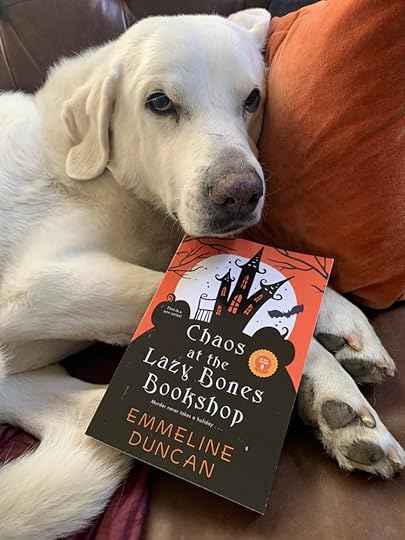
Side note, if you keep following the Columbia River until it meets the ocean, you’ll end up in Astoria, Oregon, which hosts an annual “Goonies Day” celebration in honor of, wait for it, their history as the filming site of Goonies. In 2025, they’re celebrating the 40th anniversary of the film. So, if you’ve ever dreamed of doing the truffle shuffle on the gate at Mikey’s house, next summer might be your best chance (just please respect the homeowner’s wishes!)
Readers, which movie or book town do you wish you could visit in real life? One random commenter will receive a copy of Chaos at the Lazy Bones Bookshop!

Like her Ground Rules Mystery series, Emmeline Duncan is based in Portland, Oregon. Her series includes Fresh Brewed Murder, Double Shot Death, Flat White Fatality, and Death Unfiltered, plus Fatal Brouhaha, which comes out in 2025. She’s also the author of the Halloween Bookshop Mystery Series, which launched with Chaos at the Lazy Bones Bookshop, with more to come. When not writing, she spends her time seeking out new coffee shops and hiking trails to explore, frequently accompanied by her Great Pyrenees sidekick. You can track her online at emmelineduncan.com.
August 12, 2024
Love Notes
Jessie: Popping back and forth between New Hampshire and Maine because things are glorious in both places!
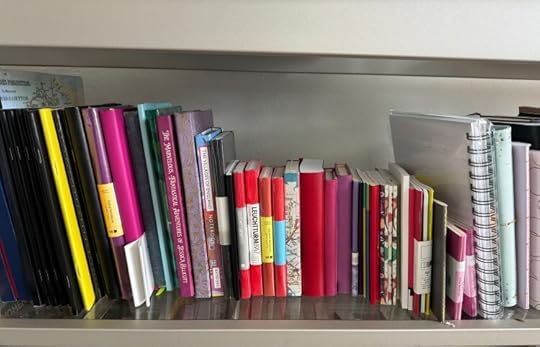
One of the things that I adore about being a writer is that it makes me look less crazy to be someone who collects so many tidbits of information without knowing why I wish to keep them. Eventually, I find uses for many of them, but when I first come across something fascinating, like the details of pigeon racing, or the rumors of a lost settlement, Norumbega in Maine I have little notion of where it will lead me.
I’ve been collecting notes for my whole life in one way or another. Like so many writers I have a fleet of notebooks, both used and brand new. I’ve used many of them to jot things down in a higgledy-piggledy sort of a way. After many years I discovered the joy of corralling notes into a commonplace book which is a far more organized and productive way of managing the flotsam and jetsom of my life. Mine contains lists of movies I want to watch, restaurants to try, museums to visit, and books to read. It also holds onto gift ideas, quotes I want to remember, and possible book titles. I keep it on my desk and either add to it or look it over often.
And then there is the traveler’s notebook style cover I picked up in the discount bin, along with two dozen paper notebooks to fill it. For some reason, the size of it is just perfect for noting down packing lists, menus for parties, and plants that would be just right for one of our gardens.
Additionally, there are the sticky notes clinging to my desk, the walls, and the backs of doors in my office. I live in constant fear of them losing their ability to stick and floating off somewhere that I cannot find. I even have brainstorming notes jotted down on the glass wall mounted to one wall of my office. I ran through dry-erase markers so quickly that I ended up buying some that are refillable in an effort not to be quite so wasteful.

But as we all know, times change. As wonderful as handwritten are, much of my world has turned digital, particularly my deliberate research. I was at a complete loss when it came to collecting those notes for years. I tried bookmarks, reading lists, and even a Word doc with links. Mostly, I just ended up with approximately 5,000 tabs open at any given moment. Honestly, I still tend to do that. But, somehow Trello came into my orbit and I had a way to save and organize those notes in a way that felt intuitive to me.
Lately, I’ve been noodling my notes and considering what sort of story I would like to tell next. I have so many intriguing snippets to choose from that I feel spoilt for choice. But as I poke and ponder I am quite sure that the next thing is already tucked away in my hoard somewhere. After all, it’s worked for nineteen novels so far!
Readers, do you have a love affair with notes? If so, how do you collect them?
August 9, 2024
Playing Cops and Robbers by Lucy Burdette
Please welcome Friend of the Wickeds, Lucy Burdette/Roberta Isleib back to the blog. Roberta is here supporting A Poisonous Palate, the 14th (!) Key West Food Critic Mystery, which released on Tuesday.

I love the covers for the Food Critic series, this one included!
Take it away, Lucy!When I first met my stepson in 1991, he was going through a phase of police adulation. Most days, he wore a miniature police uniform with his name sewn over the pocket. He carried a pretend radio everywhere and talked to his pretend police officer colleagues. He was four and this was all very cute. My husband thinks I’ve been going through a similar phase for the past few years, only I’m, ahem, quite a few years older, and possibly not quite so adorable.

But A Poisonous Palate, the newest book in the Key West series, took a different turn: much of the action takes place up the Keys in northern parts of Monroe County rather than Key West proper. This part of the county is patrolled by the Sheriff’s Department, not the Key West Police Department. That meant that Hayley Snow’s detective husband wouldn’t be involved in a case, nor would other familiar Key West police characters like Steve Torrence and Chief Sean Brandenburg.
Luckily, the Monroe County Sheriff’s Office offered their Citizens Police Academy last year, and I was able to enroll. Twelve of us citizens met for seven Thursday sessions of three hours each to learn about all the amazing things the sheriff’s deputies do. As I wrote the new book, the temptation was as always to cram in more of my newly acquired knowledge of police procedure than the story needed or could support. For example, one week the Monroe County crime scene investigator showed us his lab and had us suit up in Tyvek to learn fingerprinting, foot printing, and identification of bodily fluids. But would my food critic character Hayley Snow have an opportunity to learn all of this? Probably not. She sure shouldn’t get involved in traffic stops after a felony crime has been committed or participate with a SWAT team searching an abandoned building for criminals. I did use bits and pieces in A Poisonous Palate, and definitely discovered new characters. (Sergeant Tony Lopez was our cheerleader when we practiced shoot/don’t shoot scenarios, and he graciously agreed to have his name used for a fictional deputy.)

Much to John’s relief, I learned—again—that even if I was 50 years younger, police work would not be the profession for me. I’m terrified of driving too fast—even one video of a chase from a cruiser’s webcam gave me nightmares. Swat team work would not be for me either. Too old, too short, too nervous.
But unlike our son Andrew, I don’t see myself growing out of my fascination with police work—it seems to be a side effect of writing crime fiction.
Readers: Do you notice the details of police procedure when you read?
About A Poisonous PalateKey West food critic Hayley Snow is working on this week’s articles for Key Zest magazine when an intriguing email hits her inbox, titled “Hemingway’s toxic love and an old story.” Catherine Davitt tells Hayley that she has returned to the Keys to research a book, but she also wants to investigate the disappearance of an old friend back in the late 1970s. The two young women were part of a group of lost souls camping in the mangroves on Big Pine Key, until Catherine’s friend Veronica disappeared, and the Sheriff’s Office cleaned out the camp.
Ever-curious Hayley agrees to help her, and they travel up the islands to Big Pine Key to talk to some other islanders who were around in the 70s. They stop at an old motel to visit a man who was on the outer edges of this commune. Instead of answers, they find him murdered. It’s hard not to imagine a connection. Then Catherine disappears, leaving Hayley and Miss Gloria to unravel two possible murders, one old and one new, and track down a murderer who might very well have them in his or her sights.
When food critic Hayley Snow receives an intriguing email about a mysterious, decades-old disappearance, her curiosity is piqued. Writer Catherine Davitt has returned to the Keys to research a book about Hemingway’s wives, but she’s also on the hunt for the truth about her missing friend. Hayley quickly agrees to help investigate and they hit the road to see what clues they might find.
Back in the late 1970s, Catherine and her friend Veronica were part of a group of lost souls camping in the mangroves of Big Pine Key, until Veronica vanished, and the sheriff’s office cleared out the camp. Catherine and Hayley begin interviewing Big Pine Key residents who were around at the time of Veronica’s disappearance, but uncover more questions than answers.
Catherine and Hayley stop to speak with a motel owner who frequented the fringes of the commune, but they find him stabbed to death. Then Catherine also goes missing, and signs point to a connection between the old case and the new murder. It’s up to Hayley to unravel the knot of secrets and lies before time runs out.
Order the book wherever books are sold: https://www.penguinrandomhouse.com/books/729842/a-clue-in-the-crumbs-by-lucy-burdette/
https://facebook.com/LucyBurdette
www.instagram.com/LucyBurdette
https://www.bookbub.com/profile/lucy-burdette
About Lucy Burdette
Clinical psychologist Lucy Burdette aka Roberta Isleib is the author of 24 mysteries, including her August 6 release, A Poisonous Palate, and USA Today bestselling A Clue in the Crumbs (Crooked Lane Books), Both the twelfth book in her Key West series, A Dish to Die For and the tenth, The Key Lime Crime, won the Florida Book Award’s bronze medal for popular fiction. Her first women’s fiction title, The Ingredients of Happiness and her first thriller, Unsafe Haven, have been published by Severn House. Her cookbook, Lucy Burdette’s Kitchen, recipes and stories from the Key West food critic mysteries, was also released this month. Her books and stories have been short-listed for Agatha, Anthony, and Macavity awards. She’s a past president of Sisters in Crime, and currently president of the Friends of the Key West Library.
August 8, 2024
A Wicked Welcome to Erick Holmberg!
by Julie, with a temporary summer respite in Somerville
Today I am thrilled to help Erick celebrate the launch of his new book, . I love this post about his writing journey. Deciding to write a book is a leap of faith. Finding time to write is challenging, and I know that Erick wrote on his phone when he could grab a few minutes. He’s also a wonderful songwriter. Welcome to the Wickeds, Erick!
The Writing JourneyWhen COVID-19 swept across the world and into mine, I looked for a silver lining. There had to be one somewhere, and mine was going to be getting that novel out of my head and onto paper—or, if not onto paper, then into some faraway disk in the cloud.

The first step is the hardest, right? Well, it’s the truth. My first step was being honest about my goal, which was more of a dream, to the people closest to me. To my way of thinking, that made it real. It helped me move it from a dream to a goal. When I did that, a dear friend suggested that I take Julie Hennrikus’s writing seminar, Your Ladders.
I’m not a joiner, so I was skeptical, but the seminar was designed to demystify the artistic process. It helped me approach it as I would any other goal, as hard work that needed to be broken down into parts and tackled one at a time.
The training showed me that finding a writing community is important. Not in the rah-rah sense, but yes, that too, but rather in the ‘we have run into the same obstacles, and they can be overcome’ sense. If you have a question, you’re not in this alone and you can find an answer.
Celebrate every step of the journey. If you were like me, you might believe that the word journey is overstating it, it’s not. It’s a journey. A journey is transformational, and you will be transformed at the end. You’ll be transformed because you will have created something from nothing, and that process will change you for the better.
Celebrating each step of the journey is key. When I started the book and wrote my opening sentence. I celebrated. When I finished my first chapter, I celebrated. When I finished my first draft, I celebrated. And, by the way, there were ten drafts, so don’t get discouraged. Remember, it’s a journey.
My goal wasn’t to write WAR AND PEACE but to write the best book I could. I didn’t know how good that book would be. It might be bad, mediocre, or a bit of both, and that was okay. It just had to be my best.
I love cozy mysteries. They’re like a fire and a warm blanket on a cold winter day. They’re like homemade ice cream in the summer. I sat down to write a cozy mystery, but an urban fantasy came out. See what I mean about transformational? Be open to learning about yourself, and you’ll grow, and so will your characters.
Most of all, don’t be scared. Take the first step—write that first sentence. Celebrate each step of the journey and embrace not having a deadline. It won’t last. Find some other writers and share your experience. The next thing you know, you’ll be holding your book in your hand.
Readers, have you got a dream delayed you’d like to take on?
About Regna BornBeneath the veneer of everyday life, a clandestine world thrives in the shadows, filled with powerful telepaths who call themselves adepts. These superbeings have guarded their secrets for millennia, but when a brilliant scientist, Joe Martin, maps and prepares to publish their genome in a famous medical journal, the adepts realize they can’t hide forever and further exposure to the human world threatens their existence.
Gabriel Kelly has his life turned upside down when someone murders Joe, his ex, and the race to find the genetic map begins. Gabriel, an average adept, enlists the help of his best friend Sellers, who has his own secrets, in exposing the killer and securing the map.
Gabriel finds himself caught between the human cops who think he killed Joe and don’t know about the map, and rival adepts who don’t care who killed Joe but want the map for their own ends. Will Gabriel be the key to preserving the secrecy of adept society, or will the revelation of their existence alter the course of history forever?
About Erick Holmberg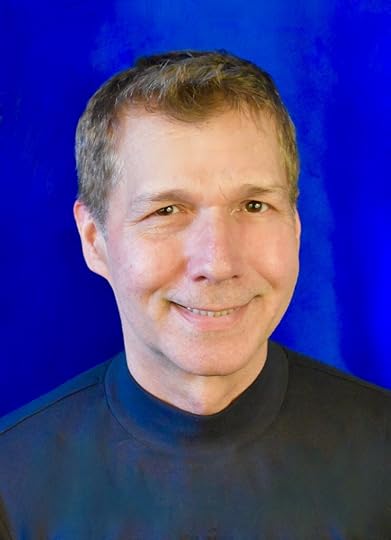
Erick grew up in Lunenburg, Massachusetts, where it was impossible to find fantasy novels with diverse characters and points of view. Erick lives in Boston with his husband and their dog, a giant Bernadoodle named Niko, and writes the books he always wanted to read and the lyrics he always wanted to hear. When he’s not writing, walking the dog, or making pasta, Erick is a vice president at an asset management firm. Regna Born is Erick’s debut novel with NineStar Publishing. Website: https://erickholmberg.com/
August 7, 2024
Wicked Wednesday – The Heat is On! Celebrating Fiery Female Protags
Happy August! Liz here, loving every minute of the warm weather but I’ve gotta admit – it’s HOT. So what better topic for Wicked Wednesdays this month than celebrating fiery, change making women?
I’ve been thinking a lot about females in books – both authors and characters – so this month we’ll talk about all of them. But let’s start with the imagined.
So Wickeds, tell me – who are your favorite women in fiction who stand up for equality and justice?

Barb: I feel like all the protagonists in crime fiction fight for justice, which is part of what draws us to the books. For this exercise, let me put forward women who have their own code of honor and sense of justice: Lisbeth Salander in Stieg Larsson’s The Girl with the Dragon Tattoo series, and Trey Reddy in Tana French’s The Searcher and The Hunter. But being fierce and damaged isn’t the only way to fight for justice. Miss Marple has a code, too.
Edith/Maddie: I like Barb’s take on the question. (TBA)
Sherry: I love Lisbeth Salander too, Barb! I also agree with what Barb said about all protagonists fight for justice. I also like Roxanne Weary (isn’t that a great name!) in Kristen Lepionka’s series and police detective Harriet Foster in Tracy Clark’s books.
Jessie: I love Persis Wadia in the Malabar House series by Vaseem Kahn. She is a determined woman in post-partition India. She doesn’t mince words, but has the best of motives for most of what she does.
Readers, who are your favorite female protagonists who are fierce about justice and quality?
Readers, add your favorite fiery women characters!
August 6, 2024
Adding Romance to Your Mystery Plot – Guest Trisha Loehr
By Liz, excited to welcome my friend Trisha Loehr to the blog today! Trisha is a romance writer and a book coach, and we’ve had a TON of conversations about adding romance to mysteries. She’s got some great tips on why this could be a great subplot- so wanted to invite her here to share with all of you! Enjoy!
Seeing a detective (either amateur or professional) figure out both a complex case and what to do with all the feelings emerging whenever that other person is nearby can be such fun.
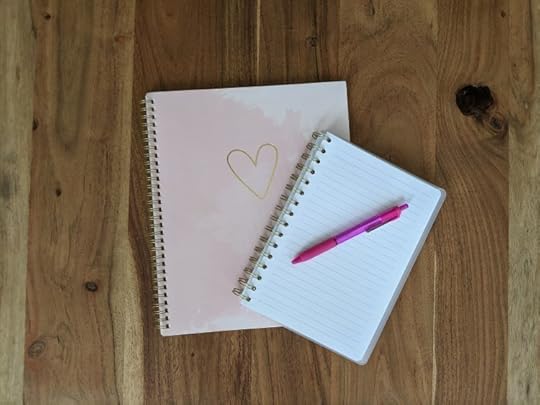
Here are four reasons why you might want to add a romantic subplot to your mystery novel.
Adding a romantic subplot to your mystery novel increases stakes, adds tension, and gives you more types of conflict to play with.
You’re probably thinking that your novel already has lots of stakes and tension. After all, somebody’s dead and we need to figure who did it before they kill anyone else. But hear me out.
When your protagonist is trying to solve a mystery while also trying to navigate a possible romantic relationship, the stakes for them personally are higher. They have to choose which problem to prioritize and then deal with the consequences of that choice.
Are they on a first date with the person they’ve been secretly in love with for a decade and then get a call about a lead in the case? If they leave now before the appetizer is even placed on the table, they likely won’t get another chance at this relationship…but if they don’t leave, the trail could run cold. Are they trying to reconcile with their true love after neglecting them for years because they’ve been so focused on solving cases only to have a murder take place on their romantic cruise? Do they involve their partner or try to hide the fact that they’re working the case at all?What happens if their love interest gets implicated in the mystery? How do they keep their emotions out of the game?Adding a romantic subplot to your mystery novel allows the reader to see other aspects of your protagonist’s character.
When you add a romantic subplot, emotions and feelings get involved. Physical desire gets involved. Confidence may give way to awkwardness. Scenes related to a romantic subplot can give readers insight into your protagonist’s wants, needs, and history. Past relationships and romantic backstory may influence decisions or interpretations of clues. And this can all lead to learning a whole lot more about what makes the protagonist click.
Adding a romantic subplot to your mystery novel creates opportunities to slow the pacing and give the reader a rest from all the action.
Sometimes mystery novels move real fast with clues dropping all over the place, people scheming and protagonists chasing down every lead. While exciting, this can get exhausting for readers.
Adding a subplot around a romantic interest may provide sweet moments of connection between characters or even humorous moments to slow the pacing and give the reader a brief rest from the more intense action.
Adding a romantic subplot to your mystery novel gives readers an opportunity to see that everyone is worthy of love.
Romance novels or romantic subplots are ways to add joy to stories and moments of tenderness that can greatly impact readers. Romance in stories can be uplifting, can tackle hard topics like self-love and self-worth and can make people feel seen and worthy of love because they get to see characters who may be similar to themselves in some way, shape or form give and receive love. That can be revolutionary for some readers.
Readers: What makes you excited or unsure about adding romantic subplots into your manuscripts? What are your favorite mystery novels that contain romantic subplots?

Trisha Jenn Loehr is a romance writer and Author Accelerator certified book coach who helps busy women who want to write romance novels without guilt or shame prioritize their writing, develop their craft, and find joy in the journey toward their publishing dreams. Connect with her on Instagram @trishajennreads and at trishajennreads.com where you can book a Free Intro Call to see if she’s the right book coach to help you.

